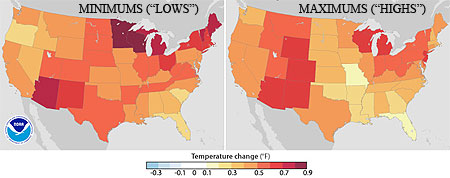Usually when you go hunting for rainbows, you turn your back to the sun. And if you’re lucky, especially if the clouds are dark enough, you get not one but two richly hued bows.
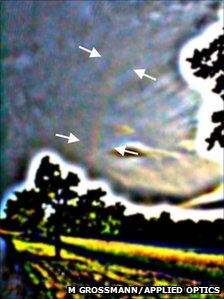
Until this year, that was all there was to the pot of gold that enthusiasts of optical phenomena could hope for. Then last year Raymond Lee, a U.S. Naval Academy meteorologist, went a step further from his classic studies of rainbows and light scattering in the atmosphere to predict that a third (tertiary), and even a fourth (quaternary) bows are possible if you look just 40 degrees from a bright sun surrounded by dark clouds.
Lee’s historical survey yielded just four potential observations of these elusive bows in more than two centuries of records. They’re barely visible, and only if you know where to look.
All of a sudden now, thanks to Lee’s guidance, two more observations have been added by rainbow chasers in Germany. They published their observations in a special issue of Applied Optics last week. To preserve the weakly lit bows on camera required special post image processing. Nonetheless we know gold when we see it. No longer is it enough to turn your back on the Sun.
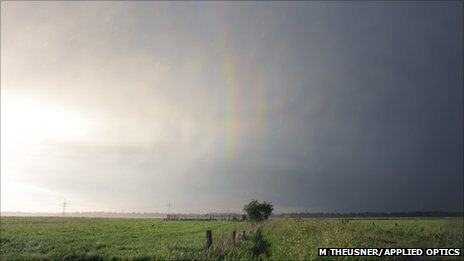
AMS Climate Course To Reach 100 More Minority-Serving Institutions
The AMS Education Program has been awarded a grant by the National Science Foundation (NSF) to implement the AMS Climate Studies course at 100 minority-serving institutions (MSIs) over a five-year period. The project will focus on introducing and enhancing geoscience coursework at MSIs nationwide, especially those that are signatories to the American College & University Presidents’ Climate Commitment (ACUPCC) and/or members of the Louis Stokes Alliances for Minority Participation. AMS is partnering with Second Nature, the non-profit organization administering the ACUPCC.
“This national network involves more than 670 colleges and universities who are committed to eliminating net greenhouse gas emissions from campus operations by promoting the education and research needed for the rest of society to do the same,” explains Jim Brey, director of the AMS Education Program. “AMS and Second Nature will work together to demonstrate to current and potential MSI signatories how AMS Climate Studies introduces or enhances sustainability-focused curricula.”
In the first four years of the project, AMS will hold a weeklong AMS Climate Studies course implementation workshops for about 25 MSI faculty members. The annual workshops will feature scientists from NOAA, NASA Goddard Space Flight Center, University of Maryland, Howard University, George Mason University, and other Washington, DC area institutions. Faculty will initially offer AMS Climate Studies in the year following workshop attendance and colleges that successfully implement AMS Climate Studies will be encouraged to build a focused geoscience curricula area by also offering AMS Weather Studies and AMS Ocean Studies.
“The major outcomes of this project will be a large network of faculty trained as change agents in their institutions, sustained offering of AMS undergraduate courses within MSIs, and the introduction of thousands of MSI students to the geosciences,” comments Brey. He notes that this project builds on the success of similar NSF-supported programs for MSI faculty implementing the AMS Weather Studies and AMS Ocean Studies courses, which together have reached 200 MSIs and over 18,000 MSI students. “We’re looking forward to working with Second Nature to continue to expand the climate course and the education that it represents.”
Mapping Ice Flow in Antarctica
A recently released map of the speed and direction of ice flows across Antarctica not only reveals some previously undiscovered geographical features, but also suggests a new explanation for how ice moves across the continent. Researchers constructed the map after studying billions of data points taken from a number of polar-orbiting satellites. After accounting for cloud cover, solar glare, and various land features, the scientists were able to determine the shape and speed of glacial formations across Antarctica. They found that some formations moved as much as 800 feet per year, and they also discovered a previously unknown ridge that runs east-to-west across the continent. The NASA animation below shows the ice flow patterns. “This is like seeing a map of all the oceans’ currents for the first time,” says Eric Rignot of the University of California—Irvine, who led the study (subscription required for access to the full article). “It’s a game changer for glaciology.” The observations also showed that the ice moves by slipping and sliding along the land, and not by being crushed and broken down by ice above it, as had previously been theorized by many glaciologists. That difference is critical to forecasting sea level rise in decades to come since a loss of ice at the water’s edge means “we open the tap to massive amounts of ice in the interior,” according to Thomas Wagner of NASA’s cryospheric program.
A Breakthrough for Antarctic Research
“It’s a big relief.”
That’s how Karl Erb, head of National Science Foundation’s Office of Polar Programs, sums up the feelings of most researchers at McMurdo Station, the headquarters of U.S. scientific research in Antarctica. The station was in danger of having its operations limited–or even of being shuttered–for at least this austral summer after the Swedish government recently announced that they would not be able to provide the Oden, the icebreaker/research vessel that the NSF has been leasing and which has been carving a path to McMurdo since 2006. Sweden claimed it needed to keep the vessel close to home after two consecutive severe winters bottled up shipping lanes in the Baltic Sea. (More recently, the Swedish government announced a five-year agreement to lease the ship to Finland for use in the Baltic’s Gulf of Bothnia.)
So the NSF, which oversees the U.S. Antarctic Program, looked elsewhere. Unfortunately, the three U.S. Coast Guard icebreakers are unable to handle the task: one is scheduled for decommission this month, one is being renovated and won’t be ready for at least two years, and the third is simply not designed for such a strenuous task as breaking through to McMurdo. With time running out to guarantee shipment of fuel and other supplies necessary to keep McMurdo operating through this austral summer, the NSF secured an agreement with a Russian vessel, the Vladimir Ignatyuk, to cut through the ice this year, and perhaps for the following two years if it’s needed. The Ignatyuk has carried out similar duties for other nations in the past, but unlike the Oden, it is not a research vessel. Scientists hoping to conduct ship-based research will have to scramble to hitch a ride on other vessels headed for the Antarctic region.
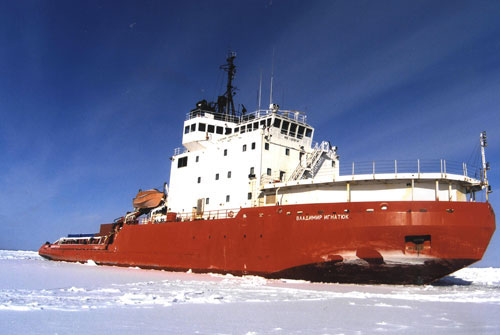
Weather-Ready or Not, Here We Come
The year so far has been expensive when it comes to disasters. Make that record-breaking expensive. According to NOAA, with nine separate big-money disasters, the losses have already reached $35 billion. In response, the NWS—in partnership with other government agencies, researchers, and the private sector—is building a plan to make the country “Weather-ready.” Earlier this week, officials from various agencies participated in a group discussion with the goal of understanding the threats extreme weather poses today and what can be done about it. Specifically, they want people nationwide to develop plans they can implement quickly to protect themselves when severe weather strikes.
“Building a Weather-ready nation is everyone’s responsibility,” comments Eddie Hicks, U.S. Council of International Association of Emergency Managers (IAEM USA) president. “It starts with the NWS and emergency managers, like IAEM USA, but it ends with action by individuals and businesses to reduce their risks. The more prepared communities are for destructive weather, the less of a human and economic toll we’ll experience in the future, and that’s a great thing for the country.”
The discussion resulted in a list of necessities to make a Weather-ready nation. They include improved precision of weather and water forecasts and effective communication of risk to local authorities; improved weather decision support services with new initiatives such as the development of mobile-ready emergency response specialist teams; strengthening joint partnerships to enhance community preparedness; and working with weather enterprise partners and the emergency management community to enhance safety and economic output and effectively manage environmental resources.
John Malay, president of the AMS, took part in the announcement and emphasized that the partnership among the three weather sectors—all represented in the AMS membership—is essential in achieving the vision. “We share the mission of informing and protecting our citizens, which is what this enterprise and initiative are all about,” he comments. “Given the resources to grow our scientific understanding of our complex environment through observations and research and to apply this knowledge in serving society, we can do amazing things together.”
You can download a pdf copy of the NWS Strategic Plan for this initiative from the Weather-ready nation website.
It's Not the Heat, It's the Aridity
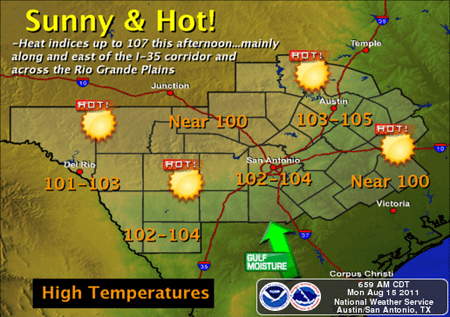
Monday’s NWS weather map looked all too familiar to most Texans. It’s been a summer of blazing sunshine and record-setting heat throughout most of the state, with so many new milestones being reached that it’s been hard to keep up.
According to the National Climatic Data Center’s national overview, July was the warmest month in state history (87.1°F; the previous average high was 86.5°F in July of 1998). Additionally, state climatologist John Nielsen-Gammon recently announced that Texas just went through its worst one-year drought on record (rainfall data goes back to 1895). At the end of July, the state had received only 15.16 inches of rain over the previous 12 months, breaking an 86-year-old record. And the year-to-date precipitation total of 6.53 inches was also a record low through the end of July, and 9.5 inches less than the historical average. According to the U.S. Drought Monitor, more than 75% of Texas is now in “exceptional” drought conditions, and last month’s rainfall total of 0.72 inches was the 3rd-driest July in state history.
“Never before has so little rain been recorded prior to and during the primary growing season for crops, plants, and warm-season grasses,” said Nielsen-Gammon.
And there appears to be no immediate end to the oppressive heat: recent forecasts predict at least another week of 100-degree temperatures in most of the state.
The conditions in Texas are typical of what much of the South has been experiencing this summer. Here are a few other numbers to chew on (preferably while you’re sitting in the shade with a tall glass of lemonade):
- According to NCDC, Oklahoma’s average temperature in July was 88.9°F, which is not only the warmest month in the state’s history, but the warmest month in any state, ever! (Oklahoma also held the previous record, which was 88.1°F in July of 1954.)
- The South climate region–which comprises Arkansas, Kansas, Louisiana, Mississippi, Oklahoma, and Texas–had an average July temperature of 86.1°F, making it the hottest month of any climate region on record. The previous record, also set in the South region, was 85.9°F in July of 1980.
- The average July temperature for the nation was 76.96°F, the 4th-warmest July–as well as the 4th-warmest month–on record, after Julys in 1936 (77.43°F), 2006 (77.26°F), and 1934 (77.00°F).
Every state in the country had at least one day of record-high temperatures in July. More U. S. climate records set during the month can be found here.
Industrial Air Pollution State by State
According to a study conducted by the Natural Resources Defense Council, an environmental advocacy organization, Ohio emits more toxic air pollution emitted from electricity-producing coal- and oil-fired power plants than any state in the country. The study utilized 2009 data taken from the Environmental Protection Agency’s Toxics Release Inventory, a database of emissions self-reported by industrial and other facilities across the United States. The report notes that 771 million pounds of toxic chemicals were released into the air in 2009 by U.S. industries, including metal, paper, food and beverage, and chemical companies. Of all the sectors mentioned in the study, power plants emitted by far the most air pollution (almost 382 million pounds), with Ohio contributing more than 44 million pounds to that figure, or about 12%. The full report can be viewed here.
The 20 states with the most toxic air pollution from power plants are:
- Ohio
- Pennsylvania
- Florida
- Kentucky
- Maryland
- Indiana
- Michigan
- West Virginia
- Georgia
- North Carolina
- South Carolina
- Alabama
- Texas
- Virginia
- Tennessee
- Missouri
- Illinois
- Wisconsin
- New Hampshire
- Iowa
Bridging Disciplines: Joint Sessions at the 2012 Annual
by Ward Seguin, 2012 AMS Annual Meeting Chair
For many years, organizers of the Annual Meeting have encouraged conferences to join forces to host joint sessions for the purpose of sharing presentations of mutual interest. A few years ago, organizers of the Annual Meeting proposed themed joint sessions that focused on the theme of the Annual Meeting.
Concerned that conferences participating in the Annual Meeting might not understand the purpose of joint sessions and, in particular, themed joint sessions, this year’s organizers decided to start the planning process early. At the 2011 Annual Meeting in Seattle, organizers for the 2012 meeting met with all of the conference committees holding meetings in Seattle to encourage future participation in the themed joint sessions. This was followed by e-mail contacts in February designed to reach those conference committees not present at the Seattle meeting.
In April, the conferences were asked to propose themed joint sessions focusing on AMS President Jon Malay’s 2012 theme of “Technology in Research and Operations–How We Got Here and Where We’re Going.“ The response from the conferences was outstanding, as 20 themed joint sessions are currently being organized. With so many conferences holding meetings in January, themed joint sessions encourage sharing of information among the government, academia, and the private sector in diverse subdisciplines. Participants are able to share their experiences of common problems and solutions, and attendees are able to take in papers related to the theme without having to move from one session to another.
Because the 2012 Annual Meeting theme is so broad, the range of topics being covered by the joint sessions provides an excellent opportunity for diverse conferences to come together. For example, one session–jointly hosted by the 10th Conference on Artificial Intelligence Applications to Environmental Science and the 18th Conference on Satellite Meteorology, Oceanography, and Climatology–is titled “Artificial Intelligence Methods Applied to Satellite Remote Sensing.” Another themed joint session, “Recent Advances in Data Management Technologies and Data Services,” will be hosted by the 28th Conference on Interactive Information Processing Systems (IIPS) and the Second Conference on Transition of Research to Operations: Successes, Plans, and Challenges. Still another session will focus on “Extreme Weather and Climate Change” and will be hosted by the Seventh Symposium on Policy and Socio-Economic Research, the 24th Conference on Climate Variability and Change, and the 21st Symposium on Education.
The format of themed joint session will include distinguished invited speakers, panel discussions, and submitted papers. Jon Malay’s chosen theme is allowing some very diverse conferences to focus together on some of today’s research and operations challenges through technology.
The deadline for abstract submissions for these sessions is August 1, and abstracts can be submitted on the AMS website at the abstracts submissions page.
AMS DataStreme Teachers Brown Bag it at NOAA
The AMS Education Program has been actively training teachers in the atmospheric, oceanic, and climatological sciences for 20 years. Over 16,000 teachers have taken part in its professional development program, DataStreme. In June, some of DataStreme-trained teachers attended a NOAA brown-bag seminar, where their presentations were seen by NOAA education officials.
The teachers—who hailed from Pennsylvania, New Jersey, and Delaware—are representatives from an AMS DataStreme Local Implementation Team (LIT). The LIT teams are run by a master teacher and local scientist. The setup provides training for teachers in a specific scientific field as well as helping them strategize ways to bring scientific information into the classroom. LIT team leader and DOE Albert Einstein Distinguished Educator Fellow John Moore was so inspired by the teachers’ hard work and creative applications of Earth Science to their classrooms that he orchestrated the brown-bag meeting to facilitate dialog between the NOAA funders and the end-result teachers.
The teachers described the positive impact of bringing real-world NOAA and NASA data into the classroom, using skills from AMS DataStreme courses. They shared how strategies developed in DataStreme Atmosphere, Ocean, and Earth’s Climate System programs could be creatively implemented in the classroom, such as introducing a climate-science section by reading a novel with a general environmental theme, or comparing “textbook” atmospheric data with real data provided by NOAA and NASA. Teachers lauded DataStreme for providing the relevance needed to keep their students excited about science and help develop them into better decision makers. Others thanked NOAA and NASA for the opportunity to bring free, real-world data into the classroom.
In addition to the live audience, the presentations were also Web cast to NOAA offices across the country. The Archived PowerPoint slides from their presentations can be accessed at http://www.lib.noaa.gov/about/news/brownbagseminars.html.
NOAA: 'Unmistakable' Global Warming Continues
NOAA released the 2010 edition of its annual State of the Climate report this week revealing that Earth’s atmospheric and oceanic temperatures are rising unabated. The 218-page report, consisting of the peer-reviewed conclusions of more than 350 researchers in 45 nations, will be distributed with the June issue of the Bulletin of the AMS.
A press briefing summarizing the report’s findings noted a “consistent and unmistakable signal from the top of the atmosphere to the bottom of the oceans” that the world continues to warm.
Those signals include last year’s global surface temperatures virtually tying 2005 as the warmest in the reliable global record, which dates to 1980. The Arctic warmed about twice as fast as the rest of the world, reducing sea ice extent to its third lowest level on record.
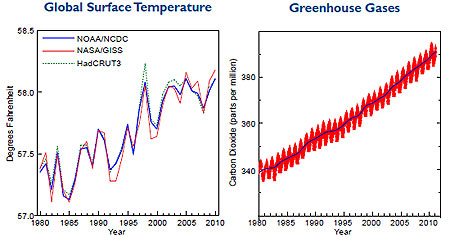
The area of Arctic sea ice was so small in September that for the first time in modern history both the Northwest Passage through northern Canada’s usually ice-bound islands as well as the Northern Sea Route along Russia’s northern coast were open for navigation.
Average sea surface temperatures (SSTs) worldwide were third warmest on record in 2010. This was despite a nearly 2°F SST drop since 2009 as major El Niño warming of the tropical Eastern Pacific during the first half of 2010 rapidly transitioned to a major La Niña cooling event.
Greenland’s ice sheet lost more mass in 2010 than in any year during the last decade. The melt rate was nearly 10 percent more than the previous record year for loss, 2007. Mountain glaciers globally lost mass for the 20th straight year.

Additionally, global ocean heat content last year was among the warmest on record, following the trend of 2009. Warmer oceans combined with glacial melting to increase average sea levels around the world.
Climate indicators tracked in the State of the Climate during 2010 also included precipitation, greenhouse gases, humidity, cloud cover and type, temperature and saltiness of the ocean, and snow cover.
The report indicated that the concentration of carbon dioxide continued to rise in 2010, surpassing 390 parts per million (ppm) for the first time. In 1979, the CO2 concentration reached 340 ppm.
The 2010 Climate Report also notes that the oceans were found to be saltier than usual in some areas, due to increased evaporation of the sea surface, and less salty, or “fresher,” than average where precipitation was more than is typical. Researchers conclude in the report that this is a sign that Earth’s water cycle is intensifying, which will lead to heavier rainfall and snow events worldwide.
Such events reached extremes in 2010, assisted in part by the transition to La Niña as well as an extraordinarily abnormal pressure anomaly in the northern Atlantic Ocean referred to as the North Atlantic Oscillation (NAO). Helping to create a blocking weather pattern over Greenland, and generating huge undulations in the jet stream, the NAO in early 2010 resulted in a lopsided winter in North America with warmer- and drier-than-usual weather in much of Canada and frigid and snowy weather in the Eastern third of the United States), and the coldest winter in more than 30 years in the United Kingdom.
While this blocking pattern eased its extreme grip across North America and Western Europe into summer, continued amplification of ridges and troughs downstream across Asia contributed to a searing summer heatwave in Russia and epic flooding in Pakistan. More than two months of above-average temperatures, including all-time record heat in Moscow, resulted in at least 14,000 heat-related deaths as well as choking wildfires. At the same time, extreme monsoon rains inundated a fifth of Pakistan, displacing more than 20 million people in normally fertile flood plains.
The year 2010 ended with unprecedented flooding across eastern Australia. The lingering La Niña pattern coupled with the enhancement in the water cycle led to the region’s wettest spring (September–November) since record keeping began 111 years ago. December precipitation in the state of Queensland was more than double the average amount, which led to massive flooding where entire geographical regions of the nation—not just cities and towns—were under water.
The overall consensus, especially when considering the dire predictions of an increasingly warmer world, is that the events and records of 2010 are the new normal on planet Earth. In one way, NOAA is confirming this today, releasing its new “climate normals” for temperature and precipitation for the United States, which serve to put into perspective current extremes based on the changing climate of the most-recent 30 years of data. The new climate “normals” valid for the period 1981-2010 have increased in temperature just as the State of the Climate has observed. Comparing the new temperature normals to those of the past decade—the period 1971-2000—shows they’ve increased by 0.5°F in that 10-year period over the United States.
“The [global] climate of the 2000s is about 1.5°F warmer than the 1970s, so we would expect the updated 30-year normals to be warmer,” NOAA National Climatic Data Center Director Thomas R. Karl says with regard to the new report.
